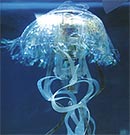I, Robot Maker
Back to Contents of Issue: December 2000
|
|
|||||
|
by Chieko Tashiro |
|||||
Last year, some 7,000 original robots competed at 50 to 60 robocons (robot contests) nationwide, with the human competitors making up the teams numbering between 20,000 and 30,000. The Robotics Society of Japan, founded in 1983, now has 3,800 members, plus some 70 corporate memberships, and more than 1,500 junior high schools in Japan offer robot-making courses (beats shop class any day). The robot-making market in Japan is valued by Robocon magazine at some ¥4.5 billion (about $41 million).
The idea for the store came after a surprisingly high audience rating for the TV show "Robot Coliseum," shown on the Fuji Television network for the first time in March. "Coliseum" features robots sumo wrestling, obstacle racing, and flaunting their creativity, artistic sense, and entertainment value before a panel of judges. Seeing the rating -- and the potential -- Tsukumo teamed up with robot hobbyist magazine Robocon to open the shop. According to Goto, the store has two distinct sets of customers. One is the robot makers, generally researchers or college students, who make robots as a hobby or for robocons. Many of these hot-rodders don't think twice about spending ¥1 million on their droids. The other set includes families wanting robot pets, which are, predictably, the store's best-sellers -- more than 10 million Poo-chis have been sold worldwide since their unleashing in April. "Pet robots are huge now," Goto says, "but we want to support the individual robot creators." He reports that small-lot orders of robot parts, which traditionally couldn't be bought in quantities of less than 100, have been picking up. Look for more picking up in the near future -- not all of it involving humans.
|
|||||
Note: The function "email this page" is currently not supported for this page.






